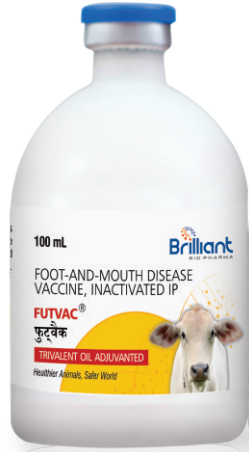National Animal Disease Control Programme (NADCP): A Much Needed Step towards Elimination of F.M.D and Brucellosis from Livestock in India
Aayush Yadav
Veterinary Assistant Surgeon, Livestock Development Department, Mahasamund, CG
National Animal Disease Control Programme, NADCP, is a principal scheme of central government with an outlay of Rs. 13,343.00 crore for five years from 2019-20 to 2023-24. The scheme is brought in action by Hon’ble Prime Minister in September 2019 and maintained by Department of Animal Husbandry, Dairying and Fisheries, Government of India with an aim of controlling Foot and Mouth Disease (FMD) and Brucellosis in livestock by 2025 by vaccinating 100% population of cattle (192.52 million), buffalo (109.85 million), sheep (74.26 million), goat (148.88 million), and pig (9.06 million) for FMD and 100% population of bovine female calves (60.25 million) of 4-8 months of age for brucellosis (BAHS, 2019). The scheme is aimed to benefit states and Union Territories with its 100% funding ability, and eradication of FMD and Brucellosis disease by 2030.
The implementation of NADCP is purely to benefit the livestock sector and reduce the financial losses to the country specially brought by FMD and Brucellosis. The losses due
| to FMD and Brucellosis are enormous and beyond estimation which cannot be only traced by the losses in milk production, draught power ability, fertility, and quality of livestock produce in FMD, or increases in abortions, infertility, production losses, and zoonotic risk in Brucellosis. The |  |
average annual economic losses to the country due to FMD is Rs. 200,000 million (DAHD, 2019), while due to Brucellosis is Rs. 92,118 million (Bardhan et al., 2020). It is, therefore, crucial to control the aforementioned diseases in livestock.
As FMD has no specific treatment, mass vaccination of susceptible livestock becomes the only choice for control of the disease. The same applies to Brucellosis in the absence of treatment where female bovine calves of 4–8 months of age are mass vaccinated. FMD vaccine is repeated at every 6 month interval till the incidence of disease comes down, while Brucella vaccine is administered once-in-a-lifetime. Prior to the one month of vaccination deworming is done. To make the event successful, public awareness campaigns and publicities are performed at national, state, block and village level. A 100% vaccination in livestock in any village requires “Muniyadi” a-day prior to the vaccination with the help of Sarpanch and Kotwars. The term “Muniyadi” refers to the “prohibition of the movement of
| the animals outside the house on the day of vaccination by giving information to the owners about the vaccination a day prior to the vaccination”. The Livestock Development Department issues an animal health card to the owner of the livestock post-vaccination bearing tag no. of animal, breed, age, date and name of vaccination, etc. (Fig 1). | 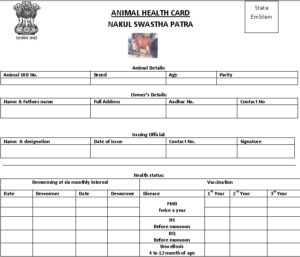 |
| Fig 1: Animal health card |
The vaccinations are only performed on those animals which are registered in INAPH “Information Network for Animal Productivity and Health”. In case the animal is un-registered, it is registered first and then vaccinated. The FMD vaccine is procured from Brilliant Biopharma Pvt. Ltd., Telangana, India by the trade name of “FUTVAC” (Fig 2).
| It is a trivalent oil adjuvant vaccine containing inactivated FMD virus antigens of types O, A, and Asia 1. The dose to administer is 2 ml in cattle, buffaloes and pigs and 1 ml in sheep and goats of 4 months of age and above, and the route is deep intramuscular. The vaccine can be administered to the pregnant animals however, to be on safer side, the | 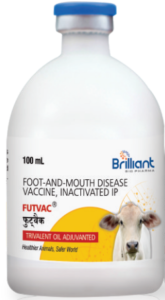 |
| Fig 2: FMD vaccine “FUTVAC” |
vaccination of the animals in advanced stage of pregnancy may be avoided (Brilliant Biopharma, 2022).
Besides, Brucellosis vaccine is procured from Sanvita Biotechnologies Pvt. Ltd., Telangana, India by the trade name of “SanBru-O” (Fig 3). It is a freeze dried Brucella abortus strain-19 live vaccine. The vaccine is reconstituted with 20 ml sterile diluent and 2 ml of it is administered to the female calves of 4-8 months of age by subcutaneous route only. Each dose of 2 ml contains 3 x 108 to 8 x 109 Brucella abortus strain-19 colony forming units. The vaccine is not administered to the pregnant animals. As the vaccine is live vaccine, it has to be administered to the animals meticulously as any contact of vaccine with the field veterinarians may lead to the severe consequences as fever, headaches, back pains, reproductive failure, etc. A PPE kit is therefore provided by the government and one must not fail to wear it before vaccinating the animals (Fig 4).
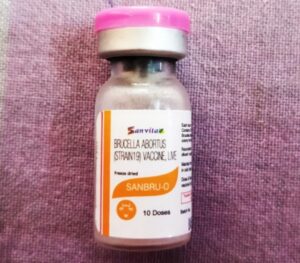 |
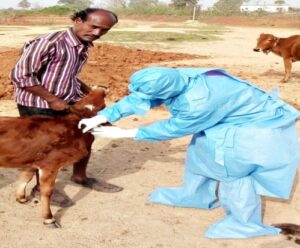 |
|
| Fig 3: Brucella vaccine “SANBRU-O” | Fig 4: Field veterinarian wearing a PPE kit and performing vaccination | |
Post-vaccination, the details of vaccination as the name and date of vaccination are entered in INAPH in the following steps.
- Open the INAPH mobile or desktop application.
- Enter the user id and password to login.
- Register the un-registered animal by clicking on “Animal Identification” icon followed by “Animal Registration Lite” and entering details such as animal details including tag number applied to the animal, gender, species, breed, registration date, age and number of calving in case of female, and owner details such as name of village, name and aadhar number of owner, date of birth and mobile number.
- The already registered animal and owner need not to be re-registered.
- Click on the “Vaccination” icon followed by “Vaccination Campaign” and enter the tag number of vaccinated animal. Select the name and date of vaccination and save the details. The vaccination details for the particular animal are saved.
- Go to the home page of INAPH and synchronize the details so that it is sent to the server.
- Repeat the procedure for the remaining vaccinated animals.
Post-vaccination, state disease investigatory laboratories shall conduct sero-surveillance for FMD and Brucellosis under this programme and must include samples from each block. Besides, the field veterinarians (vaccinator) will be provided remuneration of Rs. 3/- (FMD) and Rs. 4/- (Brucella) per vaccination dose and Rs. 2.5/- per animal for ear-tagging and online data entry in INAPH.
| With the rigorous efforts of the Livestock Development Department, untiring efforts of vaccine manufacturers, and praise-worthy efforts of Sarpanch, kotwars, and villagers the FMD and Brucella vaccinations have so far been successfully completed by 39.399 and 12.05%, respectively in India. | 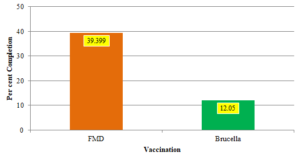 |
https://www.pashudhanpraharee.com/national-animal-disease-control-programme-nadcp/
References:
- (2019). Basic Animal Husbandry Statistics. Department of Animal Husbandry and Dairying, GOI. Assessed on May 12, 2022 at https://bit.ly/3wvjHVO.
- Bardhan, D., Kumar, S., Verma, M.R. and Bangar, Y.C. (2020). Economic losses due to brucellosis in India. Indian Journal of Comparative Microbiology, Immunology and Infectious Diseases,41(1): 19-30.
- Brilliant Biopharma. (2022). Foot-and-Mouth disease vaccine, inactivated ip: FUTVAC. Brilliant Biopharma. Assessed on May 14, 2022 at https://bit.ly/3MgHC1H.
- (2019). National Animal Disease Control Programme Operational Guidelines. Department of Animal Husbandry and Dairying, GOI. Assessed on May 16, 2022 at https://bit.ly/37N6Iq2.


